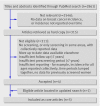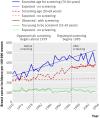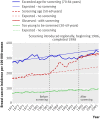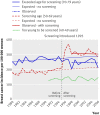Overdiagnosis in publicly organised mammography screening programmes: systematic review of incidence trends
- PMID: 19589821
- PMCID: PMC2714679
- DOI: 10.1136/bmj.b2587
Overdiagnosis in publicly organised mammography screening programmes: systematic review of incidence trends
Abstract
Objective: To estimate the extent of overdiagnosis (the detection of cancers that will not cause death or symptoms) in publicly organised screening programmes.
Design: Systematic review of published trends in incidence of breast cancer before and after the introduction of mammography screening.
Data sources: PubMed (April 2007), reference lists, and authors. Review methods One author extracted data on incidence of breast cancer (including carcinoma in situ), population size, screening uptake, time periods, and age groups, which were checked independently by the other author. Linear regression was used to estimate trends in incidence before and after the introduction of screening and in older, previously screened women. Meta-analysis was used to estimate the extent of overdiagnosis.
Results: Incidence data covering at least seven years before screening and seven years after screening had been fully implemented, and including both screened and non-screened age groups, were available from the United Kingdom; Manitoba, Canada; New South Wales, Australia; Sweden; and parts of Norway. The implementation phase with its prevalence peak was excluded and adjustment made for changing background incidence and compensatory drops in incidence among older, previously screened women. Overdiagnosis was estimated at 52% (95% confidence interval 46% to 58%). Data from three countries showed a drop in incidence as the women exceeded the age limit for screening, but the reduction was small and the estimate of overdiagnosis was compensated for in this review.
Conclusions: The increase in incidence of breast cancer was closely related to the introduction of screening and little of this increase was compensated for by a drop in incidence of breast cancer in previously screened women. One in three breast cancers detected in a population offered organised screening is overdiagnosed.
Conflict of interest statement
Competing interests: None declared.
Figures








Comment in
-
Overdiagnosis and mammography screening.BMJ. 2009 Jul 9;339:b1425. doi: 10.1136/bmj.b1425. BMJ. 2009. PMID: 19589820 No abstract available.
-
Breast screening overdiagnosis. Stop treating indolent lesions.BMJ. 2009 Aug 11;339:b3256. doi: 10.1136/bmj.b3256. BMJ. 2009. PMID: 19671607 No abstract available.
-
Breast screening overdiagnosis. Consensus and decision aids.BMJ. 2009 Aug 11;339:b3260. doi: 10.1136/bmj.b3260. BMJ. 2009. PMID: 19671608 No abstract available.
-
Breast screening overdiagnosis. Protocols are evidence based.BMJ. 2009 Aug 11;339:b3262. doi: 10.1136/bmj.b3262. BMJ. 2009. PMID: 19671610 No abstract available.
-
Screening: is breast cancer overdiagnosed?Nat Rev Clin Oncol. 2009 Dec;6(12):682-3. doi: 10.1038/nrclinonc.2009.172. Nat Rev Clin Oncol. 2009. PMID: 19942923
References
-
- Vainio H, Bianchini F. IARC handbooks of cancer prevention vol 7: breast cancer screening. Lyon: IARC Press, 2002.
-
- Welch GH. Should I be tested for cancer? California: University of California Press, 2004.
-
- Welch HG, Black WC. Using autopsy series to estimate the disease “reservoir” for ductal carcinoma in situ of the breast. Ann Intern Med 1997;127:1023-8. - PubMed
-
- Gøtzsche PC, Olsen O. Is screening for breast cancer with mammography justifiable? Lancet 2000;355:129-34. - PubMed
Publication types
MeSH terms
LinkOut - more resources
Full Text Sources
Medical
Miscellaneous
